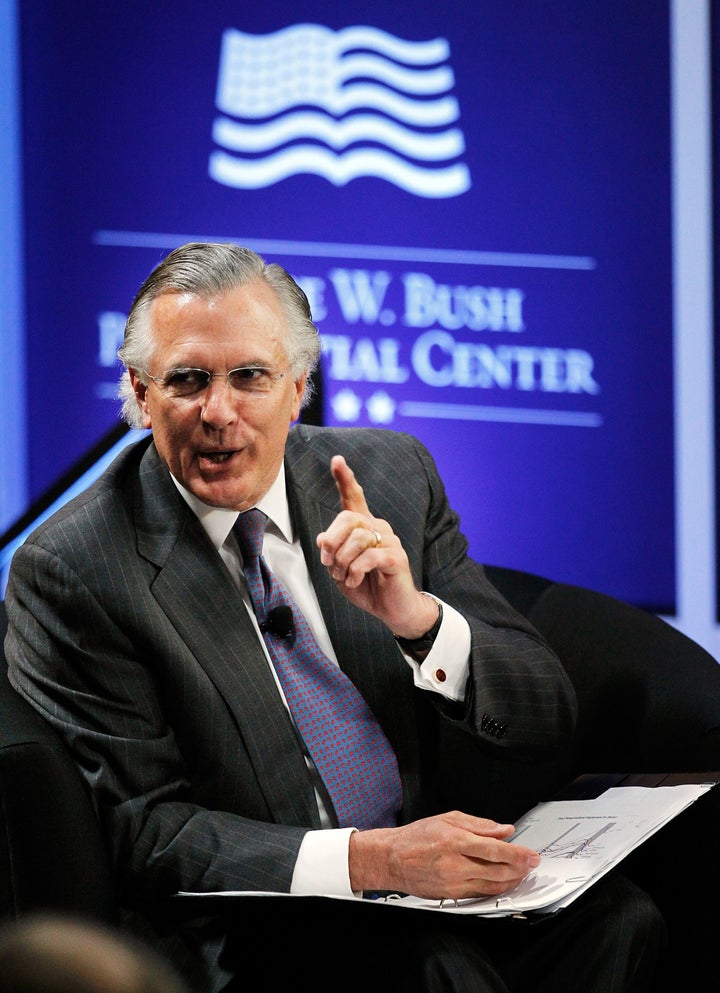
NEW YORK -- Investors will likely view the Federal Reserve's recent decision to keep short-term lending rates near zero for the next two years as part of a strategy to protect traders from stock market losses, a top central bank official warned on Wednesday.
"[T]he Federal Reserve should never enact such asymmetric politics to protect stock market traders and investors," Richard W. Fisher, president and chief executive of the Federal Reserve Bank of Dallas and a voting member of the central bank's Federal Open Market Committee, said in prepared remarks. The FOMC effectively sets the main short-term lending rate between banks, which affects rates on loan products ranging from mortgages to car loans.
Some investors believe the central bank, led by Fed Chairman Ben Bernanke, has an unofficial policy of bailing out stock market investors by lowering interest rates to encourage stock purchasing, thereby driving up equity prices.
If this view -- often referred to as the "Bernanke Put" -- becomes widely held, the danger is that investors will come to rely on the Fed to bail them out of losing positions, thus encouraging recklessness and diverting cash from productive uses like investment to speculative activity.
The Dow Jones Industrial Average fell 9 percent between July 21 and Aug. 5, the day credit rating agency Standard & Poor's downgraded U.S. debt. On Aug. 8, the first trading day after the downgrade, the index suffered a 600-point loss. The Chicago Board Options Exchange Volatility Index, a measure of investor anxiety also known as the VIX, surged to 48, its highest close since the current bull market began in March 2009.
The next day, Aug. 9, the central bank voted that it would keep the short-term rate, known as the federal funds rate, at a range between 0 and 0.25 percent well into 2013, citing the tepid economic recovery and uncertainty about future growth. Fisher was one of three Fed dissenters. The Dow Jones index closed up nearly 430 points that day.
"Given the extent of the drop in the stock market leading up to and following Standard & Poor’s downgrade of U.S. debt, combined with the FOMC’s commitment to hold short-term rates near zero until mid-year 2013, some cynical observers might interpret such a policy action as a 'Bernanke Put,' " Fisher said.
A review of available speeches and testimony by Federal Reserve officials reveals no other instance where a sitting regional Fed president or member of the Fed's Board of Governors in Washington has referred to the Bernanke Put.
"[O]ur action might be interpreted as encouraging the view that there is an FOMC so-called Bernanke Put that would be too easily activated in response to a reversal in the financial markets," Fisher said. The concept, he explained, refers to the belief that a central bank "will allow the stock market to rise significantly without tightening monetary policy, but will ease monetary policy whenever there is a stock market 'correction.' "
Though it's likely the first time a sitting Fed official has publicly warned against Fed actions that encourage such a view, Bernanke has faced these criticisms before.
In February 2008, a month before the fall of investment bank Bear Stearns set off financial panic, Sen. Richard Shelby of Alabama, the top Republican on the Senate Banking Committee, asked Bernanke how he'd respond to critics who wondered if there was a Bernanke Put.
The Fed chairman noted that the central bank looks at a broad range of indicators to inform its view of future growth and the pace of inflation, including the price of U.S. stocks.
"Financial asset prices are important for the economic outlook partly because they affect household wealth and thus consumer spending on goods and services and therefore ultimately influence output, employment, and inflationary pressures," Bernanke said. Declines in asset prices "may adversely affect the outlook for aggregate demand, and consequently the stance of monetary policy may need to be eased in order to cushion the effect on aggregate demand," he added.
But Fed efforts to stimulate the economy "have not insulated from substantial losses investors who made poor investment choices," Bernanke said. As an example, the Fed chairman referenced investors in tech stocks, who suffered massive losses in the early 2000s "despite considerable monetary policy easing."
During an interview last December, a leading hedge-fund manager, David Einhorn, head of Greenlight Capital Inc., said that the Fed appears to be more concerned with stock prices than the typical hedge-fund manager.
"One of the things that I have noticed through the crisis, at least my own personal perception, is it sometimes feels that the Federal Reserve is more concerned about which way the next 50 points in the S&P go than your average hedge fund manager is," Einhorn said Dec. 6 during an interview on The Charlie Rose Show.
"And I would not have expected that before the crisis."
* * * * *
Shahien Nasiripour is a senior business reporter for The Huffington Post. Send him an email at shahien [at] huffingtonpost [dot] com, follow him on Twitter at @nasiripour, or call him at 1-917-267-2335.
